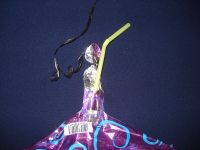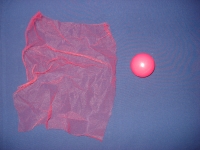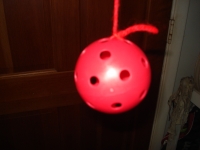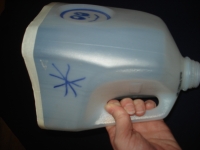Strengthening the Large Muscles aka Gross Motor Early Intervention
Strengthening large muscle groups (gross motor skills) helps with balance, strength, eye-hand coordination, eye-foot coordination, and overall body coordination (proprioception). This can be done in many ways and starting from an early age. It is important to help your child learn to be aware of where there body is in space. As we go through some techniques to developing these skills, there is a general guideline to remember: Children develop from the head down and from the center of the body outward...the head develops before the feet and the shoulders before the hands.
In all of these things it is important to remember to never tease a child by calling them a clutz. Even if they have these tendencies, early intervention can help with that.
From early on, eye-hand coordination can be developed with the use of a mylar balloon hanging from above (on a mobile, etc.) so that the child can watch it. It is light and small enough that the child can make it move easily. Infants move their bodies to practice using their muscles. If they can make something else move at the same time, they will do it more!

Soft ribbon is another tool to connect a child's limb to their mobile. As they flail a wrist or an ankle, the mobile will dance above them. The ribbon can be moved after a couple of minutes to the opposite hand or foot. Once the child is doing this on purpose, give them plenty of opportunities to use their limbs (like using the balloon as mentioned above). Start with the hands until they recognize what they are doing then move on to the feet.
Plug for language development: As the child moves their hands, say aloud to them: "wave". As they move their feet, say to them: "kick". And so on, and they will come to know the words associated with the movements.
At around the age of six months, many babies can sit up. Bring out the trusty mylar balloon and hang it again from above, but this time sit the child up with pillows surrounding them to ensure a soft landing if they topple. This is the progression from lying on their back and hitting the balloon to sitting up and trying to hit it.
Hitting Sequence:
- Use a mylar balloon hung from above and hit with hands.
- Change to a wiffle ball hung and hit with hands.
- Switch to a tennis ball and hit with hands.
- As they gain control of their hands, introduce hitting with paddles. All of this helps with the gross motor muscles used in racket and paddle sports that use the upper body.

*We can enhance the development of children by building on parts of the activity that they already know. Be sure to reinforce this with positive feedback.*

At some point in these preschool years, a child can progress to the beginning of catching a ball with their hands. We suggest a soft or plush ball that is not completely inflated. A normal toddler catch looks like the parent throwing the ball and it bounces off of the child's chest onto the ground and then their hands come together. As the art of catching is practiced more and more the skill of reaction time is being developed. The nerves that go to the muscles involved are getting a fally coating (myelination) on them as they develop which makes the nerve impulse stronger and clearer with age and use.
*We're not aiming for perfection, we're doing these activities to help with development.*
With any kind of development, motor or cognitive, all of this is based on breaking a task down into small, doable parts. For example, learning to catch the scarf comes before learning to catch a ball. Then comes catching a big ball with the arms before catching a smaller ball with the hands (remember the arms develop before the hands and the hands catching comes before feet kicking).
*If a child is having trouble with something, look back to check if a step has been missed.*
Related Posts
By accepting you will be accessing a service provided by a third-party external to https://growthandgiggles.com/



